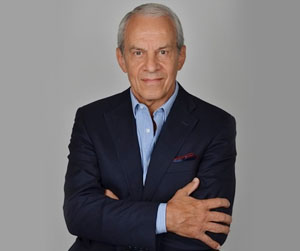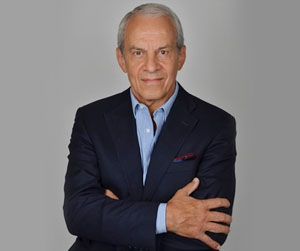Breast augmentation and breast lift
Sagging breasts cause aesthetic and personal discomfort because of the importance of the breast in the image of femininity and the female psyche.
This breast sagging (ptosis) is sometimes associated with a certain degree of asymmetry and, in some cases, with shrivelling skin around the areola.
Breast sagging may be due to a loss of volume, most often due to weight changes or after pregnancy.
The aim of the operation is to raise and reshape the breasts, correct any asymmetry, and restore tension to the slackened skin to obtain a shape that is in harmony with the patient's body shape and her wishes.
A breast lift combined with breast implants is a good way to achieve these goals.
There are many models of prostheses whose outer shell, content, volume, shape and projection can suit the individual anatomy of each patient.
A prosthesis is like an internal garment and must fit the body with the maximum comfort and harmony. Under these conditions, the patient "forgets" about the prostheses and these become completely integrated as part of her natural body image.
Uses
Depending on the degree of breast sagging, the technique for lifting the breast and fitting the prosthesis will vary:
Moderate sagging
This is generally for breasts that have lost their volume. Sagging is not significant in terms of the vertical position but is an issue in terms of the anteroposterior position (a lack of projection).
This breast sagging can be corrected by the lifting effect obtained by restoring volume through prostheses, if possible without leaving a scar on the breast and using the axillary route. This means the scar is hidden in the fold at the bottom of the armpit.
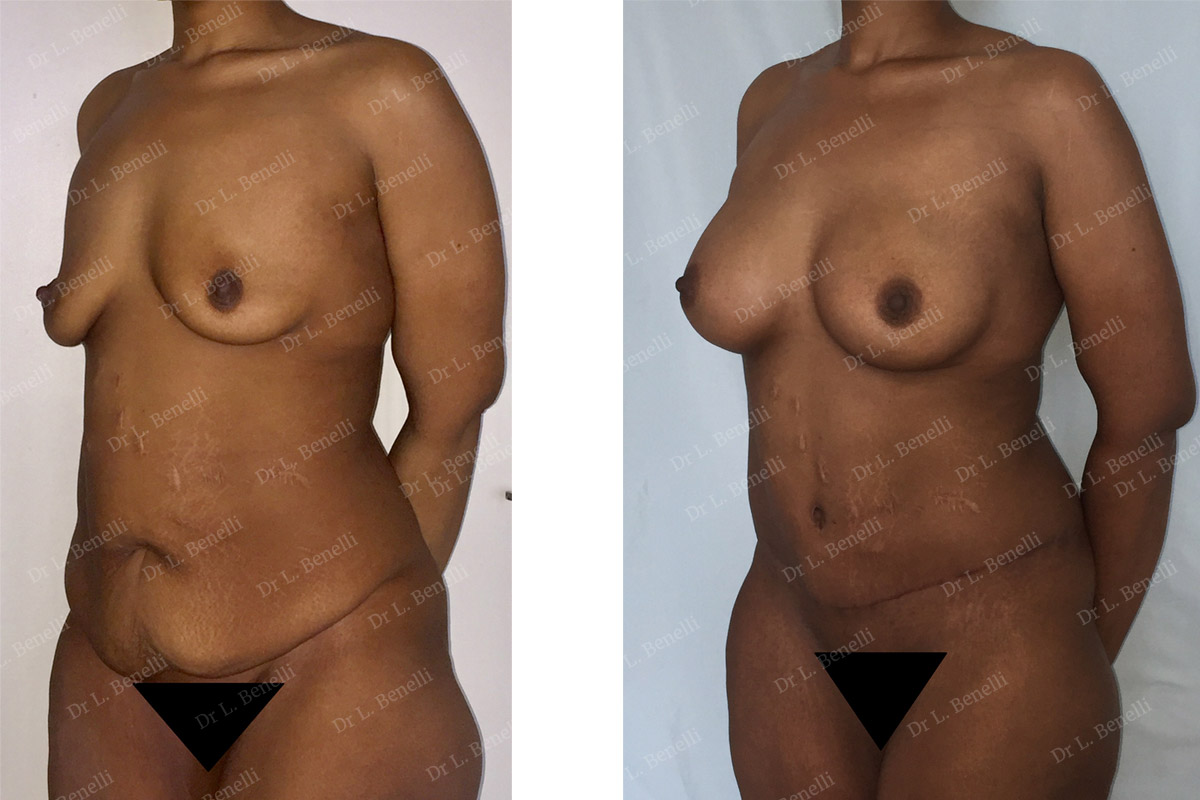
A breast lift by inserting axillary prostheses without a scar on the breast and simultaneous abdominal plastic surgery.
Significant sagging
In cases where there is significant breast sagging and the areola is in a very low position, using prostheses will not be enough to correct this ptosis and a breast lift will also be needed.
Very often, the scar from a breast lift can be limited to a periareolar circular scar using the "Round Block" technique. There is no vertical scar under the areola and no scar in the submammary fold.
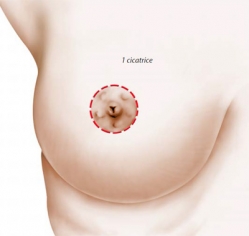
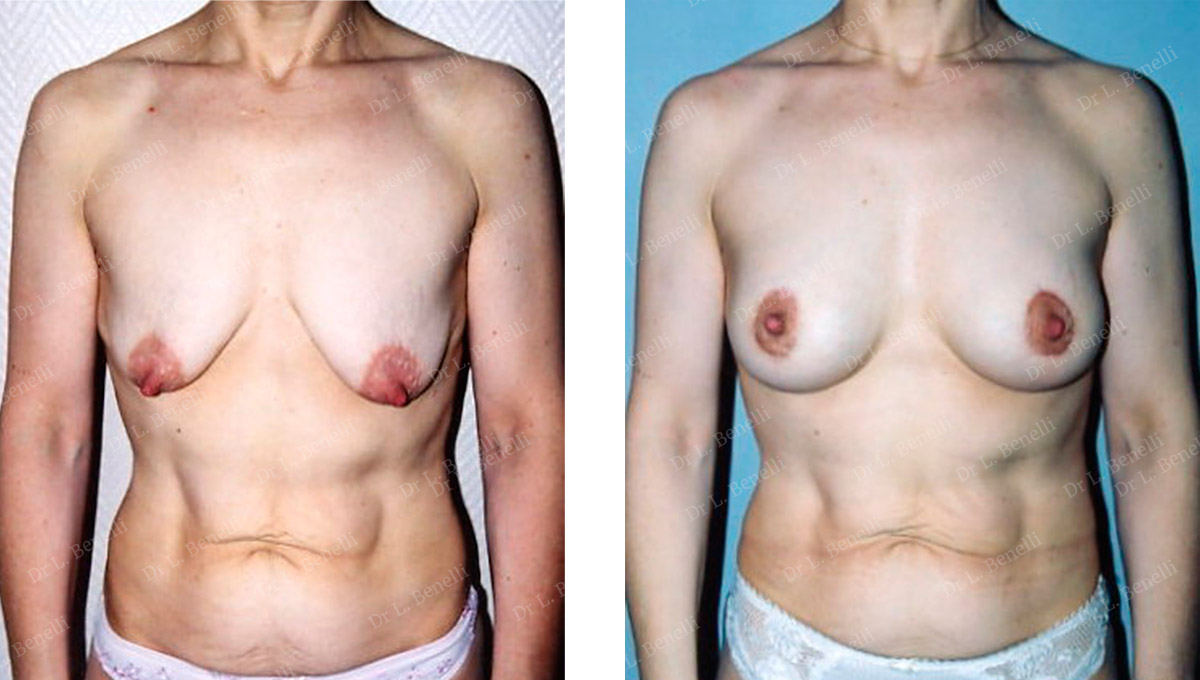
Ptosis treatment with the "Round Block" technique, leaving no scar under the areola and a volume increase using anatomical prostheses.
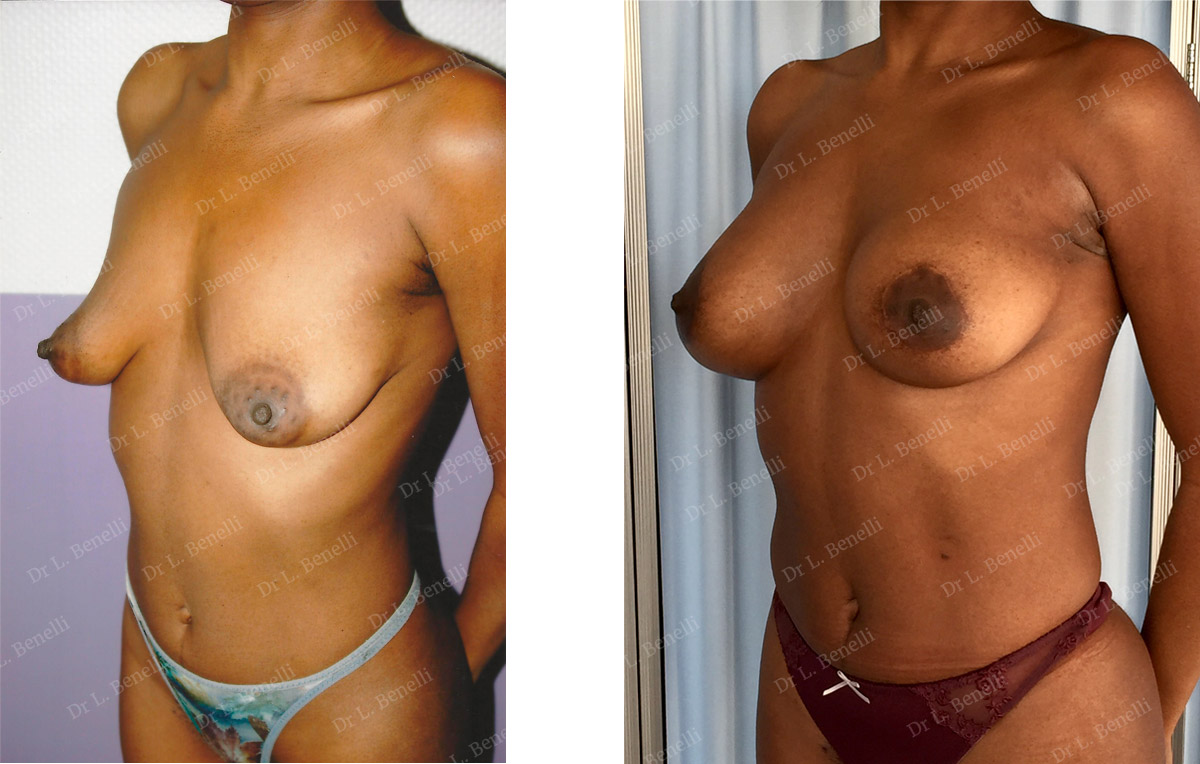
Ptosis treatment with the "Round Block" technique, leaving no scar under the areola and a volume increase using anatomical prostheses.
Consultation
During the first consultation, it is essential that you openly express what bothers you and what you would like to improve. Do not be afraid to ask any questions, including expressing your fears and expectations. Everyone has a different body shape, psychology and expectations. These are not the same and there is no standard to apply.
After you have explained your motivations, I will examine you and propose one or more solutions, taking into account your expectations, your anatomy, respecting your identity and the natural aspect of your appearance.
During the first consultation, I will evaluate the technique to use, the type of prosthesis and its volume.
So you can visualise the desired result, I will show you photos of surgical results from cases similar to yours so you can understand the objective of the procedure, depending on the type and volume used.
What is a breast prosthesis?
A breast prosthesis is a volume substitute aiming to create a curve in all areas similar to that of a natural breast in terms of its look and feel, both in a standing position and lying down.
A breast prosthesis consists of an outer shell and its contents.
There are different types of prostheses that vary in the texture of their shell, filling content, shape and volume. The different types of usable prostheses are described in chapter 160; Breast augmentation using prostheses.
It is essential that you and I have a good understanding when deciding to operate and to determine the technique to use from among those I can suggest.
I will then give you all the information on the techniques proposed along with the information sheets from the Société Française de Chirurgie Plastique Reconstructrice et Esthétique (French Society of Plastic, Reconstructive and Cosmetic Surgery) as well as a detailed estimate of the costs for the options chosen. You will then be able to progress your project and get ready for a second consultation when you will be able to ask any additional questions to help you make a decision and prepare for the operation.
Before the procedure
Preoperative examinations should be performed:
-
Breast ultrasound and/or mammography to check breast health. These will allow the diagnosis of any anomalies that can be treated during the operation or will potentially lead to additional preoperative examinations.
-
A blood test.
If you intend to have a general anaesthetic, you will need a consultation with the anaesthetist in the weeks preceding the operation and at least 48 hours before.
You will need to shave your armpit a few days before the operation if the prosthesis is to be inserted using the axillary route.
You will need to buy a bra specifically adapted to the post-operative support and this will be prescribed for you. It must be brought on the day of the operation to be worn at the end of the operation.
RECOMMENDATIONS
-
No medication containing aspirin or anti-inflammatories can be taken within 10 days of the procedure.
-
If you are having a general anaesthetic, you must fast strictly for 6 hours before the operation (do not eat anything, chew gum, eat sweets, or smoke).
-
Tobacco consumption should be stopped or reduced as much as possible during the month before and month after the procedure. Tobacco can cause scarring problems.
The procedure
Hospitalisation and the duration of the operation
Your stay in hospital is usually limited to the night following the operation. Same-day discharge is also possible after a few hours of monitoring following the operation. During the night, painkillers and analgesics are given by drip if you are staying in hospital or are taken in tablets at home. Going home the next day, you will need to wear a simple support bra on top of the dressings.
The procedure lasts about 1.5 hours.
Type of anaesthetic
In most cases, the operation is performed under general anaesthesia.
Technique
Before you go to the operating theatre, in your room, I will go over the precise goals with you that we agreed during the consultations. You can then always make recommendations and ask any questions. I will then draw the lines and marks on your skin to guide the operation and the lines of the incisions.
For moderate sagging, the prostheses are usually inserted through the axillary route.
This has the advantage of not creating a scar on the breast and only leaves a discreet scar hidden in the hollow of the armpit and limited to the area covered by hair.
It also means that the mammary gland is not cut and this keeps all the tissues intact to cover the prosthesis. The tissues are lifted to one side for the axillary technique and a cavity is formed for the prosthesis.
Preserving the integrity of tissues keeps all the elasticity needed to cover the increase in volume, contributing to a natural feel.
Some special surgical instruments are used (specific removal tools and/or endoscopy equipment).
With significant sagging, simply using prostheses will not be enough to lift the breasts. In most cases, the breast lifting technique used will be, the periareolar "Round Block" technique, without a vertical scar under the areola and no scar in the submammary fold.
If, however, sagging and excess skin are very significant, it may be necessary to add a vertical scar between the lower part of the areola and the submammary fold. The "Round Block" technique, on the other hand, can avoid a horizontal scar in the submammary fold, which results from classic inverted T-shaped techniques. Here, the excess skin is essentially repositioned downwards in the submammary fold, whereas the periareolar "Round Block" technique creates a vertical scar under the areola and positions all the excess skin upwards over the periareolar and vertical sub-areolar scar. This leaves no horizontal scarring in the submammary fold.
After the operation
During the night and days following the operation, there may be a painful sensation of tension in the area that was operated on such as aches and pains, which may impede mobility. These pains are moderate in a resting position and may require analgesics that are given by a drip during your stay in hospital or are taken as tablets at home. These post-operative pains will diminish and disappear within a few days of the operation.
If drainage is used, it will be removed the day after the operation.
The dressing will be completely removed during the first post-operative consultation one week after the operation and replaced by a waterproof adhesive dressing. This allows you to take showers and must be changed every 8 days.
As the stitches used are absorbable, they do not need to be removed. Placed internally in the skin’s thickness (intradermal stitches), they are invisible.
Swelling (oedema) and bruising in the chest area are usually very moderate and it takes about ten days for these to disappear almost completely.
It is necessary to foresee a professional unavailability of 4 to 5 days in the majority of cases.
Care
In addition to wearing a support bra day and night for 1 month, a waterproof dressing for taking showers should be changed every 8 days over a 1-month period.
You will need to attend a follow-up visit about a week after the procedure, then after 15 days, 1 month, 3 months, 6 months and 1 year.
Recommendations
-
Do not raise your arms too high and avoid heavy physical exertion.
-
You may resume sporting activities 1 month after the operation, wearing a support bra and limiting yourself to painless movements.
-
The recommended rest position is lying on your back, slightly raised if possible. You can also lie on your side but you must not lie on your front.
-
Exposure to the sun: no direct exposure before 1 month, then exposure is possible using a sun protection cream with a maximum sun protection factor. No exposure as long as there are bruises or the scar is pink.
-
Pregnancy and breastfeeding: Breastfeeding is possible but it is advisable to wait for 6 months before considering a pregnancy so that the breasts have settled into their final form.
The result
The new shape of the breasts is immediately visible despite any swelling. Even if the shape is initially a little taught, it will soften in the weeks following the operation.
Realigning the excess skin around the areola can initially produce some periareolar wrinkles, which are more or less prominent depending on the excess skin removed. These will completely go away after a few weeks or months.
It takes 1 to 3 months for the tissues to heal and the breast to be flexible and natural, with all its sensitivity.
The healing around the prosthesis forms a capsule, a flexible membrane that will surround the prosthesis to isolate it from the surrounding tissues and allow the prosthesis to be integrated into the body as far as possible.
In the long term, the result will be stable and sustainable.
The average life of a breast prosthesis was estimated at 10 or 15 years but, for new generation prostheses, which are manufactured to higher strength standards than before, the average life should be longer.
Over time, a prosthesis undergoes a normal wear and tear that will cause it to lose its waterproofness. Any leak in the prostheses usually requires both to be changed. The integrity of breast prostheses is checked during annual consultations.
In addition to an aesthetic improvement, this operation has a beneficial impact on the patient's personal well-being and development.
Risks and complications
Scale of charges
The cost of the operation will depend on the procedure to be carried out, the duration of the operation, the type of anaesthetic and any hospital charges.
If the reason for the operation is purely aesthetic, you do not have the right to reimbursement by Social Security. On the other hand, if it is for reconstructive purposes, you may be covered by Social Security and, if necessary, by your mutual insurance company.
A detailed estimate is given to you during the first consultation according to the options chosen. You then have a minimum legal period of 15 days to consider your options and take your project forward.
The first consultation costs €50. The follow-up consultations before and after the operation are free.
The photographs on this page are here to illustrate and complete the information given on the operation. They are merely for information purposes so you can see the goals, results and scars from the operation.
The likelihood of scarring and each patient’s individual anatomy are different. For this reason, therefore, the photographs on this site do not commit Dr. Benelli to providing all patients with a similar result.
The information given on a site is not sufficient in itself and a medical consultation is essential to get the right information for each individual case. For this, you will need to consult a surgeon qualified in Plastic Reconstructive and Aesthetic Surgery.
